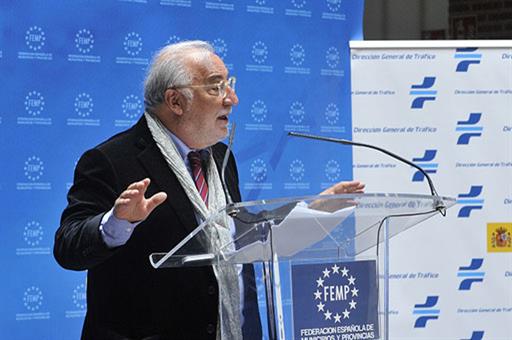Entry into force on 11 May
DGT and FEMP present Manual on application of new speed limits on urban streets
News - 2021.4.13
This Manual is created with the aim of promoting and helping municipal authorities effectively apply this modification to the General Traffic Regulation through real examples that can be found in the streets of the cities of Spain.
The document graphically develops specific examples in which a section of the road is described schematically, reference is made to the specific part of the rules that apply and, lastly, the example is consolidated through a real graphic case.
The Manual will be sent to all local authorities and will be available on the web page of the DGT and of the FEMP to be downloaded.
According to Pere Navarro, "the presentation of this manual, one month before the entry into force of the new speed limits in built-up areas, is the result of a decisive commitment by public authorities to collaborate. This reduction in the speed limits in our streets will allow municipal authorities to create more user-friendly and more humane cities in which different users of streets can co-exist more safely because with speeds in excess of 30km/h, safety for all users that interact cannot be guaranteed".
For his part, Alfonso Gil highlighted that "this new reform of the Regulation will have a very significant impact. We are going to see how such aspects as footwear, walking and cycling gain space, thus creating cities with less smoke and noise". He added that "healthy mobility will conquer the future and make our cities more competitive, cleaner and safer, while boosting local commerce".
In addition to the Manual, an explanatory video has also been developed, which was shown during the presentation in which some of the transformations can be seen that may be implemented in cities at a town planning level following the application of these new speed limits.
More than enough reasons
The modification of the Traffic Regulation containing the speed limits in built-up areas was approved at the Council of Ministers on 10 November. In order for these changes to become familiar to the public and so that local authorities had enough time to adapt road signs and/or infrastructure, a six-month period was granted from the publication of the Royal Decree in the Official State Gazette before its entry into force.
Hence, as from 11 May, the speed limits on urban streets will be
a) 20 km/h on roads with no distinction between the road and the pavement.
b) 30 km/h on streets with a single lane in each direction.
c) 50 km/h on two-way roads with two or more lanes in each direction.
The reasons behind the introduction of this measure by the DGT, which has been highlighted by the Directorate-General for Mobility and Transport of the European Commission as a positive measure that will help reduce road accidents, are:
- The demand from local councils to have an overreaching legal regulation and be able to apply a 30km/h speed limit in their municipalities.
- In 2019, the number of people who died in traffic accidents in urban areas rose by 6%, while it fell by 6% on intercity roads.
- 82% of deaths in built-up areas in 2019 were vulnerable users, in other words, pedestrians, cyclists and motorcyclists.
- The risk of death as a result of being run over falls by 80%: if the speed of the vehicle involved in the collision is 30 km/h, the risk is 10%, if the speed is 50 km/h, the risk of death rises to around 90%.
- The distance required to stop the vehicle when slowing down from 50km/h compared with 30km/h drops by half.
- Existing pilot projects in 30 built-up areas shows the positive effect on the accident rate, with reductions in the number of accidents that have even exceeded 40%.
- Environmental noise falls by half, according to the report on recommendations of the Group of Academic Experts at the 3rd Global Ministerial Conference on Road Safety.
And furthermore… global trend
In addition to all these reasons is that the reduction in speed limits in built-up areas to 30 km/h is one of the priorities of the 2030 Agenda, with the aim of turning cities into safer areas, reducing both the risk of suffering an accident and their seriousness.
The 2020 Stockholm Declaration, drawn up following the 3rd Global Ministerial Conference on Road Safety, in its eighth recommendation, "establishes a maximum travelling speed limit of 30km/h in urban areas".
In addition, the European Union, within the framework of European policies on road safety for the period 2021-2030 bases its approach on the "Safe System", in which roads and vehicles must be designed to assimilate a margin for human error without causing serious injury or death and the speed limits permitted for vehicles are one of the components of the safety level provided for the other parts of the system.
Lastly, the slogan chosen by the United Nations for this year's 6th Global Road Safety Week, to be held from 17 to 23 May 2021, also focuses on a reduction in the speed limit to 30 km/h in built-up areas, entitled "Streets for Life #Love30".
Non official translation





